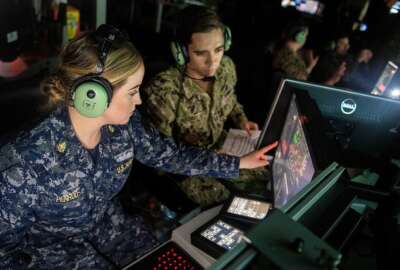Federal robocallers must now have consent to drop you a line
In today's Federal Newscast: The FCC rules that government contractors must have consent before robocalling. The president is strengthening the leadership at the...
To listen to the Federal Newscast on your phone or mobile device, subscribe in PodcastOne or Apple Podcasts. The best listening experience on desktop can be found using Chrome, Firefox or Safari.
- When it comes to robocalls, federal contractors are now considered “persons” under the Telephone Consumer Protection Act (TCPA). The FCC reinterpreted a 2016 decision that said federal contractors could make robocalls without prior consent. Now the commission says vendors must obtain consumer consent before making robocalls. Under the 1991 law, the TCPA generally requires “any person” making certain calls to get the recipient’s prior express consent, but contractors were not considered “persons” under a previous interpretation. The commission also clarified that federal and state government callers, when acting in an official capacity, are not subject to TCPA prior-consent requirements.
- The Office of the Director of National Intelligence is calling on President Donald Trump to rescind a 10-year-old executive order on handling and labeling controlled unclassified information (CUI). In a memo obtained by the Federation of American Scientists, Director of National Intelligence John Ratcliffe said the current CUI system is too complex and that he supports a new executive order setting governmentwide standards for this information. CUI refers to more than 100 categories of unclassified but sensitive information, such as taxpayer data, health records and law enforcement information.
- The Army is rolling out a plan to make its bases more integrated with technology. Army installations will follow a new plan that will make bases highly connected and aware of their surroundings through technology. The guide, signed by the Army’s top leaders, says future bases will have an array of sensors to diagnose issues remotely and train soldiers from anywhere. Buildings and infrastructure will be adaptable and have multiple uses. The Army also wants its installations to have resilient power and water sources and be able to defend in multiple arenas. Army officials said this new way of thinking about installations will prepare the service for 2035 and beyond.
- The White House looks to staff up leadership at the Postal Service. President Donald Trump plans to nominate former Syracuse mayor and former Deputy HUD Secretary Roy Bernardi to serve on the USPS Board of Governors. Bernardi led day-to-day operations at HUD in the George W. Bush administration. But he more recently served as a senior adviser for the professional services firm CohnReznick and as vice president of government relations for CGI Technologies. The board currently has three vacancies and the Postal Service doesn’t have a deputy postmaster general.
- Good government groups worry the Office of Personnel Management is not cooperating with the presidential transition. OPM has not released a new transition guide for agencies. And it has not temporarily suspended hiring review boards for the Senior Executive Service. Both are common OPM activities during past presidential transitions. This comes as the White House released a new order of succession for OPM leadership. The order details who should lead OPM should the agency’s top two appointees resign. The new line of succession favors political appointees over longtime career executives. (Federal News Network)
- The Department of Veterans Affairs said its facilities in New Orleans and Bedford, Massachusetts are the first to begin vaccinating frontline healthcare workers and patients. Those two facilities are among the 37 medical centers that will receive the first shipments of the Pfizer vaccine this week. A 96-year-old World War II veteran was the first VA patient to receive the COVID-19 vaccine yesterday. Veterans at VA’s long-term care and spinal cord injury centers will be among the first patients to receive the vaccine.
- The State Department is trying to fix a long-standing cybersecurity coordination challenge. A new enterprise chief information security officer will try to bring the State Department’s often disparate approaches to cybersecurity together. The new E-CISO will report to the CIO and have broad authority to oversee all aspects of cybersecurity. State CIO Stuart McGuigan says any bureau, including Diplomatic Security, that maintains their own cyber infrastructure will be responsible to the E-CISO for meeting all required cyber standards and conducting risk assessments. Under the E-CISO, the agency also is establishing the Office of Global Information Technology Risk, which will develop policy, procedures and templates so offices can conduct and report the results of those risk assessments. (Federal News Network)
- Senior Navy and Marine Corps leaders say they plan to conduct a sweeping new review of the $4 billion they spend on information technology each year. Details of the new review haven’t yet been announced, but a joint memo co-signed by several officials says there is a dire need to identify the Navy Department’s “cyber terrain.” The memo notes too many of the Navy and Marine Corps’ IT systems still are not interoperable with one another – let alone the rest of DoD and its international partners.
- As the Space Force is about to celebrate its first birthday, the service passed a large milestone: The first people to directly enlist into the Space Force finished their basic training. The seven new members of the Space Force include five men and two women. The service plans to increase its trainees over time and eventually recruit more than 300 by the end of 2021. There are currently another 13 trainees in basic training and seven more preparing to arrive.
Copyright © 2025 Federal News Network. All rights reserved. This website is not intended for users located within the European Economic Area.
Peter Musurlian
Peter Musurlian is a producer at Federal News Network.
Follow @PMusurlianWFED
Related Stories
Related Topics
Agency Oversight
All News
Contracting
data security
Federal Communications Commission
Federal Drive
Federal Newscast
Management
Marine Corps
military bases
Office of Personnel Management
Office of the Director of National Intelligence
Postal Service Board of Governors
robocalls
Space Force
State Department
Stuart McGuigan
Tom Temin





